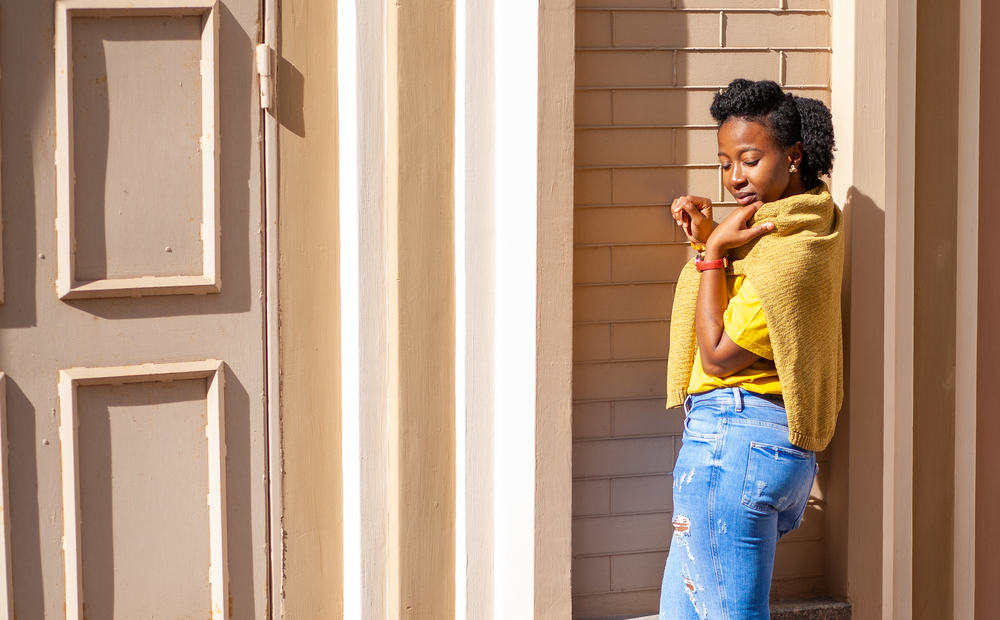
Mold is a nuisance wherever it is encountered. It creeps up in spoiled food or on ceilings after a rainy season, but can your hair get moldy? That’s the question people all over are asking. In this article, you’ll find out once and for all if your hair can get moldy (or mildew).
Table of Contents
Can Your Hair Get Moldy?
Your hair can get moldy. Mold is a type of fungi that feeds on moisture to grow. The average person moisturizes their hair at least twice a week and washes it every week or so, making your hair and scalp susceptible to mold growth.

Why Mold Should Be Promptly Addressed
Exposure to mold (and mold spores) in any form can potentially be dangerous to your health. When mold grows, it can emit potentially hazardous byproducts into the atmosphere that can cause illnesses or exacerbate existing conditions. It is crucial to avoid mold at all costs because of its inherent dangers.
What Mold Looks Like
Moldy hair is unmistakable. It can appear as patches of green, gray, or yellow discolorations throughout the hair or on the scalp. Mold that has festered in the hair for an extended time may produce an off-putting smell. Some people refer to moldy hair as "mildew hair".
Mold is Preventable
Mold is an issue that countless people in the natural hair community have faced. Because people see mold as gross or dirty, there’s also a stigma surrounding mold growth.
But there is no reason to be ashamed if you develop mold in your hair. You can easily avoid moldy hair by knowing what causes it. Keep reading to learn common causes of moldy hair.

Causes of Moldy Hair
Mold takes time to grow in any environment, especially on the hair. Mold growth is usually caused by hair care mistakes made continuously over time.
Many make these mistakes unknowingly due to a lack of education on proper hair care. Here are some of the most common causes of moldy hair.
1. Excessive and Constant Moisture
Contrary to what you may have heard about natural hair, you can over-moisturize your hair. Moisture is necessary to help your hair and scalp thrive, but too much moisture can cause your hair to become a breeding ground for mold (or mildewed hair with a musty smell).
People tend to over-moisturize their hair by constantly spraying and drenching it with water, never allowing it to dry completely. Read this article to learn more about how often to moisturize your hair.
2. Wearing Certain Hairstyles While Your Hair Is Wet
We all love to experiment with our hair. But some hairstyles leave your hair more vulnerable to mold growth, especially when done on moist or wet hair.
These styles include:
- Buns
- Updos
- Ponytails
These styles force the hair into a position where moisture can become trapped. They also make it difficult to dry your hair thoroughly.
Locs are especially prone to mold growth because they are made up of matted and tangled hair, it naturally takes them longer to dry than loose hair would.
Constantly leaving your hair wet can quickly lead to mold infestation on the scalp and throughout the length of the locs, sewn-in
If you have very thick hair it's even more critical that you wash your hair thoroughly and allow it to dry completely. Also, read this article if you need to detox your dreads or this article if you need a dreadlocks maintenance regimen.

3. Excessive Sweating on the Scalp
Sweat is the body’s natural way of cooling itself down. Sweat can appear anywhere there is an opening or pore on the skin. The scalp is full of pores that secrete sweat and oils daily. If a buildup of scalp sweat isn’t aired out, it will accumulate, allowing mold to grow.
This is the same reason why a sweaty gym bag can breed mildew and mold, surface fungus, and ultimately cause health problems if not remediated.
4. Product Buildup
If not distributed evenly, creams, oils, moisturizers, and other hair care products get trapped in the hair, leaving behind moisture. Any moisture or barrier that prevents the hair from drying will contribute to mold growth.
5. Sleeping With Wet Hair
Hair that has not dried after washing or swimming is full of moisture (damp or moist areas) that mold can feed on. Covering wet hair with a scarf or plastic cap can further promote mold growth.
Moisture is enough for mold to begin growing, but adding a plastic cap or head covering to the mix traps heat as well, which speeds up the growth of the fungus.

Get Rid Of Hair Mold Fast
If you have a case of hair mold, don’t panic. There are many effective ways to remove mold without cutting all your hair off. Please note that these tips may not work for everyone.
If they don’t work for you, we advise you to consult a professional hairstylist or your primary care physician.
DIY Tea Tree Oil Treatment
Tea tree oil is a versatile essential oil with numerous benefits for the hair and scalp. It has antifungal properties that can help kill mold. Follow the steps below for a DIY tea tree oil pre-wash treatment.
- In a spray bottle, mix two tablespoons of tea tree oil with two cups of water.
- Saturate your hair with the solution, focusing on areas where you see mold.
- Let the solution sit on the hair and scalp for 20 to 30 minutes.
- Shampoo and condition your hair as usual. Rinse hair with warm water.
- IMPORTANT: Allow your hair to dry completely before covering or styling it.
If you don't have tea tree oil at home (or you're not the DIY type) there are several other natural scalp cleansers that can be made with essential oils. However, using a clarifying or antifungal shampoo is also an option.
Wash Hair With Clarifying Shampoo
Washing hair with a sulfate-rich clarifying shampoo can help to rid the hair and scalp of mold along with debris and buildup. Clarifying shampoos contain chelating agents that break down dirt, product residue, and oil.
It may take more than one wash day to eliminate your hair of all traces of mold. Monitor your hair and scalp closely to ensure that all fungus is removed.
Wash Hair With an Antifungal Shampoo
Since mold is a type of fungus, antifungal shampoo is a great way to keep mold at bay. Like clarifying shampoo treatments, antifungal shampoo treatments may need to be used several times to eradicate the mold.

How To Prevent Moldy Hair
Dealing with moldy hair can be quite an ordeal. Although it is possible to grow mold in your hair, most people will never have to experience it. That’s because avoiding mold is pretty straightforward. Follow the tips below to become an honorary anti-mold expert.
Always Allow Hair To Dry Completely
Drying your hair correctly is paramount to maintaining mold-free tresses. Since mold thrives on excess moisture, you have to be meticulous about how long you allow your hair to remain moist.
After washing your hair, gently towel dry it to remove most of the water. If you are pressed for time, use a blow dryer or hooded dryer to accelerate the process. Otherwise, allow your hair to air dry as much as possible before styling.
Never Sleep with Wet Hair

Sleeping with wet hair should be avoided at all costs. Pressing your wet hair against a pillow for hours creates the perfect environment for mold growth - high levels of trapped moisture. Covering your wet hair overnight can further increase mold production.
If you’re concerned that you may fall asleep before your hair is dry, try washing your hair early in the morning to give your hair ample time to dry. People living in warm, sunny climates can also sit outside and let the natural heat dry their hair.
Choose Hairstyles Wisely When Hair Is Wet
If you don’t plan on drying your hair with a blow dryer or hooded dryer, leave it as free and loose as possible. A wash n’ go hairstyle will work fine. Avoid putting it in a tight bun, ponytail, or updo.
These styles restrict airflow from reaching the entire scalp and the full length of your hair. Don’t put your wet hair in a braided style, either. Dry it thoroughly before starting the braiding process.
- Why Does My Hair Smell Like Wet Dog?
- Do Dreadlocks Smell?
- Sea Salt and Lemon Juice for Dreadlocks
- Is Rose Water Good for Dreads?
Mold can be a significant problem if left untreated. But it can certainly be avoided through thoughtful hair care routines and preventative measures.
Keep in mind that mold will only grow under the right conditions. By following the tips outlined in this article, there will be no opportunity for your hair to harbor any mold.




